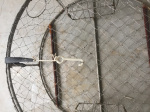Fish Report for 11-14-2016
Bowfishing for Bullfrogs?

by Carrie Wilson
11-14-2016
Website
Question: In the regulations it says it’s legal to use bow and arrow to take bullfrogs. Does this mean we are also allowed to take them using compound bows? (J. Riggs)
Answer: Yes, compound bows are legal for taking bullfrogs as long as the arrow shaft or the point, or both, are attached by a line to the bow or to a fishing reel (California Code of Regulations Title 14, section 1.23). Bow fishing for bullfrogs will also require you to have a California sport fishing license. Amphibians may be taken only by hand, hand-held dip net, or hook and line, except bullfrogs may also be taken by lights, spears, gigs, grabs, paddles, bow and arrow or fishing tackle (CCR Title 14, section 5.05(e)). Since there are some protected frog species that may coexist with bullfrogs, please be sure you are correctly identifying your frog as a bullfrog, Rana (Lithobates) cataesbeiana, before releasing your arrow!
Lead ammo on Native American reservations?
Question: I have a relative with land that borders a Native American reservation. For the past 40 years I have hunted doves and quail on his ranch. I talked to a tribal member next to the ranch and he said they still use lead shot and bullets when they hunt, and if they lease the part of the ranch where I hunt, I could still use lead shot there because they are a sovereign nation. He also said I did not need a California hunting license, stamps or tags except from the tribal government. I always love to read your column. Please advise me if this information is correct. (Jay S.)
Answer: Non -tribal members (you), even if given permission by a tribe to hunt within the tribe’s reservation or on its lands, may still be required to have a valid California hunting license, stamps and tags and comply with California hunting laws. Check with a California Wildlife Officer to confirm whether you will need. A non-tribal member may also be required to comply with tribal hunting and fishing regulations within a tribe’s reservation. Also, federal law prohibits entering tribal lands without permission for the purpose of hunting and transporting wildlife taken in violation of tribal law, so hunters are encouraged to contact the tribe before hunting within a tribe’s reservation or on tribal lands.
Tribal members within their own reservation, with very limited exceptions, are subject to federal and tribal fish and wildlife laws, rather than state laws. The lead ammo ban would not apply to them within their own reservation (Fish and Game Code, section 12300, 16 US Code sections 3372 and 18 US Code section 1165).
Rotten cotton?
Question: I am trying to make my crab traps compliant with the new “rotten cotton” regulations that require escape features must be threaded with single strand untreated cotton of no greater than size 120. My traps are tied with multi strand cotton. I cannot find single strand cotton cord. All the places that sell replacement cord seem to carry only multi strand. I was thinking of untwisting the multi strand cord and using the single strands. Any suggestions? (Walter)
Answer: Twine size is based on the diameter of the line, which is based on established size reference tables. You must use a single strand of untreated cotton twine size 120 or less. “Single strand” in the regulations refers to one strand of whatever cotton twine (legal size) that a person may choose to use. It does not refer to the number of strands that make up the single strand of cotton twine. Commercial crab fishermen have been required to include escape openings using this “rotten cotton” for many years without problems. If you’re having trouble finding it, check fisherman supply warehouses or businesses that sell commercial fishing supplies.
“Starting Aug. 1, 2016, crab traps shall contain at least one destruct device of a single strand of untreated cotton twine size No. 120 or less that creates an unobstructed escape opening in the top or upper half of the trap of at least five inches in diameter when the destruct attachment material corrodes or fails” (CCR Title 14, section 29.80(c)(2)).
Carrie Wilson is a marine environmental scientist with the California Department of Fish and Wildlife. While she cannot personally answer everyone’s questions, she will select a few to answer each week in this column. Please contact her at CalOutdoors@wildlife.ca.gov.
Photos
More Reports
California Department of Fish & Wildlife Reports
for Thursday, November 10th, 2016
: Dungeness Crab Season Update
: Fall Turkey Season Opener Approaches
Hunters report deer tags or face fine

11-7-2016
The California Department of Fish and Wildlife (CDFW) reminds all deer tag holders they must report their hunting results, even...... Read More

Website Hosting and Design provided by TECK.net

